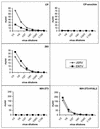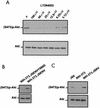Envelope-induced cell transformation by ovine betaretroviruses
- PMID: 11991967
- PMCID: PMC137058
- DOI: 10.1128/jvi.76.11.5387-5394.2002
Envelope-induced cell transformation by ovine betaretroviruses
Abstract
Ovine betaretroviruses include Jaagsiekte sheep retrovirus (JSRV) and enzootic nasal tumor virus (ENTV). JSRV and ENTV represent a unique class of oncogenic retroviruses that induce tumors of the respiratory tract. JSRV and ENTV are highly related but induce different diseases. Expression of the JSRV envelope (Env) induces transformation of rodent fibroblasts in vitro and phosphorylation of Akt, a central player in the phosphatidylinositol 3-kinase (PI-3K)/Akt signal transduction pathway. However, little information is available on the molecular biology of ENTV. In this study, we initially assessed whether the ENTV Env has the same properties as the homologous JSRV protein. We performed entry and interference assays using retroviral vectors pseudotyped with either the JSRV or the ENTV Env and sheep choroid plexus cells, choroid plexus cells stably expressing the JSRV Env protein, human 293T cells, mouse NIH 3T3 cells, or NIH 3T3 cells expressing human hyaluronidase 2 (HYAL2), the cellular receptor for JSRV. The results obtained indicated that ENTV and JSRV share the same receptor in sheep cells and that they can use human HYAL2 as a cellular receptor in mouse cells. The ENTV Env induces transformation of rodent fibroblasts in vitro. As with the JSRV Env, the tyrosine at position 590 is critical for ENTV Env-induced cell transformation, and Akt is phosphorylated in ENTV Env-transformed cells but not in the parental cell lines. Thus, ovine betaretroviruses share a common mechanism of cell transformation. We further investigated the relevance of Akt activation in cells transformed by ovine betaretroviruses. A PI-3K inhibitor blocked Akt phosphorylation in JSRV Env-transformed cells, suggesting a possible involvement of PI-3K in JSRV and ENTV Env-induced cell transformation. In addition, phosphorylated Akt was detected in a cell line derived from a lung tumor of a sheep with naturally occurring ovine pulmonary adenocarcinoma.
Figures






References
-
- Alian, A., D. Sela-Donenfeld, A. Panet, and A. Eldor. 2000. Avian hemangioma retrovirus induces cell proliferation via the envelope (env) gene. Virology 276:161-168. - PubMed
-
- Ausubel, F. M., R. Brent, R. E. Kingston, D. D. Moore, J. G. Seidman, J. A. Smith, and K. Struhl (ed.). 2000. Current protocols in molecular biology. John Wiley & Sons, Inc., New York, N.Y.
-
- Bai, J., J. V. Bishop, J. O. Carlson, and J. C. DeMartini. 1999. Sequence comparison of JSRV with endogenous proviruses: envelope genotypes and a novel ORF with similarity to a G-protein-coupled receptor. Virology 258:333-343. - PubMed
-
- Bellacosa, A., J. R. Testa, S. P. Staal, and P. N. Tsichlis. 1991. A retroviral oncogene, akt, encoding a serine-threonine kinase containing an SH2-like region. Science 254:274-277. - PubMed
-
- Chang, H. W., M. Aoki, D. Fruman, K. R. Auger, A. Bellacosa, P. N. Tsichlis, L. C. Cantley, T. M. Roberts, and P. K. Vogt. 1997. Transformation of chicken cells by the gene encoding the catalytic subunit of PI 3-kinase. Science 276:1848-1850. - PubMed
Publication types
MeSH terms
Substances
Grants and funding
LinkOut - more resources
Full Text Sources
Other Literature Sources
Research Materials
Miscellaneous

